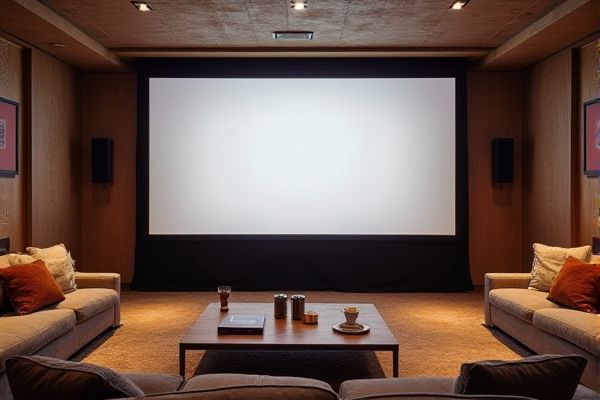
Pull-down projector screens offer versatility and space-saving benefits, making them ideal for basements with limited room or multi-purpose uses, while fixed frame screens provide a consistently taut surface for superior image quality. Explore the rest of this article to determine which option best suits your basement setup and viewing preferences.
Table of Comparison
| Feature | Pull-Down Projector Screen | Fixed Frame Screen (Basement) |
|---|---|---|
| Installation | Ceiling or wall mounted, retractable | Wall mounted, permanently fixed frame |
| Space Efficiency | Saves space when not in use | Requires dedicated wall space |
| Screen Material | Flexible, tensioned when extended | Tightly stretched, rigid frame |
| Image Quality | Potential for minor wrinkles or waves | Consistently flat, excellent image stability |
| Durability | More prone to mechanical failure over time | Long-lasting with minimal maintenance |
| Cost | Generally lower upfront cost | Higher initial investment |
| Ideal Use | Temporary or multi-use rooms, flexible setups | Dedicated home theaters or basements |
| Basement Suitability | Works well in low ceiling basements | Best for large, dedicated basement walls |
Introduction to Basement Home Theater Screens
Basement home theater screens demand careful selection between pull-down projector screens and fixed frame screens to maximize viewing quality in limited spaces. Pull-down screens offer flexible storage, retracting when not in use, ideal for multipurpose basements, while fixed frame screens provide a taut, wrinkle-free surface enhancing image sharpness and contrast. Your choice impacts installation ease, screen size options, and overall durability tailored to basement lighting and room dimensions.
What is a Pull-Down Projector Screen?
A pull-down projector screen is a retractable display surface mounted on a roller mechanism, designed to extend or retract vertically from the ceiling or wall, ideal for basement home theaters with limited space. Unlike fixed frame screens, pull-down models offer flexibility by allowing the screen to be concealed when not in use, preserving the room's aesthetics and functionality. Their portability and ease of installation make pull-down screens a popular choice for optimizing viewing experiences in basement environments with varying lighting conditions.
What is a Fixed Frame Projector Screen?
A fixed frame projector screen is a tensioned, rigid display surface mounted on a permanent frame designed for optimal image quality with enhanced tension and flatness. Ideal for basement home theaters, it eliminates wrinkles and maintains consistent screen tension, ensuring vibrant colors and sharp visuals. Your choice of screen type influences the viewing experience, with fixed frames providing a superior, stable surface compared to pull-down screens.
Space Efficiency: Pull-Down vs Fixed Frame
Pull-down projector screens offer superior space efficiency in a basement setup by retracting into a compact housing when not in use, freeing up valuable wall space. Fixed frame screens occupy a permanent position, requiring dedicated wall area that may limit furniture arrangement and overall room versatility. Your choice should consider how much open space you need when the screen is not deployed and how often you use the projector for optimal basement functionality.
Installation Process and Flexibility
Pull-down projector screens offer easy installation with ceiling or wall mounts, allowing you to retract the screen when not in use, maximizing your basement's space flexibility. Fixed frame screens require a more permanent installation on a wall, providing a consistently taut and stable viewing surface but limiting your room layout options. Your choice depends on whether you prioritize quick setup and space adaptability or a seamless, dedicated projection area.
Image Quality Differences
Pull-down projector screens in basements often provide flexibility but may suffer from slight image distortion and lower tension, impacting sharpness compared to fixed frame screens. Fixed frame screens maintain a perfectly flat, taut surface that enhances image uniformity and color accuracy, crucial for dark basement environments with controlled lighting. The consistent tension of fixed frames minimizes wrinkles and shadows, delivering superior contrast and pixel clarity for optimal home theater experience.
Durability and Maintenance
A fixed frame screen in a basement offers superior durability due to its rigid frame that maintains tension and shape over time, resisting warping or sagging in humid conditions. Pull-down projector screens require more regular maintenance, as the rolling mechanism can accumulate dust and the screen surface may develop creases or dirt that affect image quality. Choosing a fixed frame screen ensures your setup remains consistently high-quality with minimal upkeep, especially in basement environments prone to moisture.
Cost Comparison
Pull-down projector screens typically cost between $100 and $400, making them a budget-friendly option for basement setups. Fixed frame screens often range from $300 to $1,000 or more, depending on size and material quality, representing a higher initial investment. The cost difference reflects the fixed frame's superior tension and image stability versus the pull-down screen's portability and ease of storage.
Aesthetics and Room Integration
Pull-down projector screens in basements offer a sleek, minimalist aesthetic by retracting into the ceiling when not in use, preserving clean lines and maximizing wall space. Fixed frame screens create a permanent, polished look with taut, flat surfaces that enhance image quality and add a defined focal point to your entertainment area. Your choice depends on whether you prioritize seamless room integration with subtle design or a dedicated, professional-grade viewing centerpiece.
Which is Best: Pull-Down or Fixed Frame for Your Basement?
Pull-down projector screens offer flexibility and space-saving benefits ideal for multipurpose basements, easily retracting when not in use, while fixed frame screens provide superior image quality with tensioned surfaces that eliminate wrinkles and enhance color accuracy. Basements with limited wall space or irregular wall shapes may benefit from pull-down models, whereas rooms dedicated to home theater setups often favor fixed frame screens for their stable installation and optimal viewing experience. Selecting between pull-down and fixed frame screens depends on your basement's usage, room dimensions, and desired image performance.
 homyna.com
homyna.com